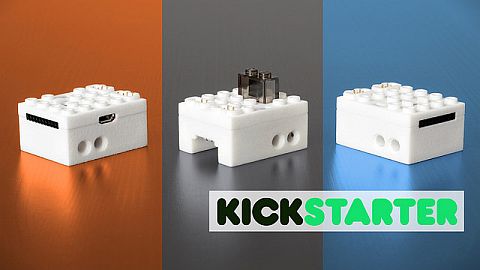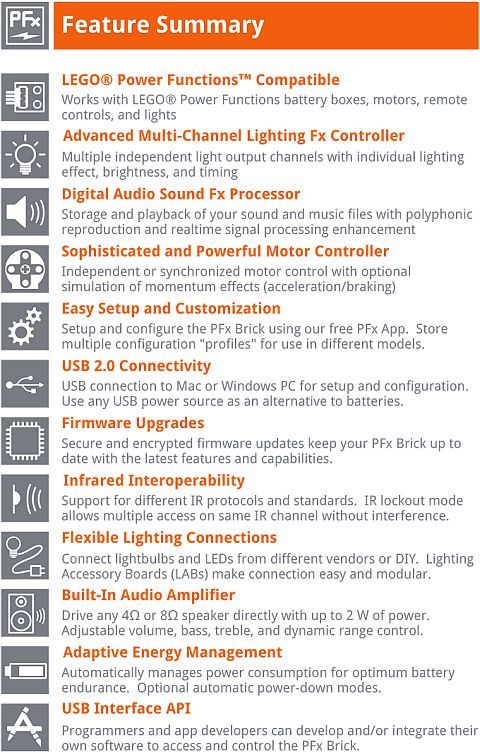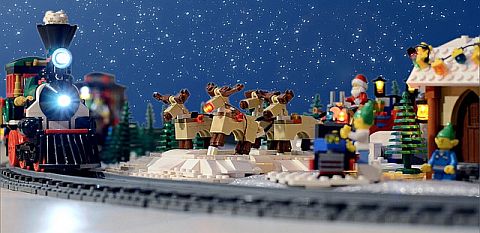LEGO fans Jason Allemann (jkbrickworks.com) and Michael Gale (brickdimensions.com) have been developing a new, LEGO-compatible light/sound/motor controller called PFx Brick. We have featured many of Jason’s amazing LEGO creations previously (see links at the end of this post), so you know that whatever he is involved in is going to be good. Jason and Gale are currently running a Kickstarter campaign to put the PFx Brick into volume production and make it widely available for LEGO fans everywhere. I have been in touch with Jason, and he sent us over some really interesting information about the project. Details below. 🙂

➡ WHAT IS THE PFX BRICK? – Lights, sound, action; these three words perfectly summarize the essence of the PFx Brick. Never before have these capabilities been available on a single device, in such a small form factor, and designed specifically for LEGO builders. That is, until now! The PFx Brick is an electronic brick controller designed to offer three major functions for your LEGO creations: 1.) Motor control, 2.) Lighting effects and 3.) Sound effects. These functions are controlled using any LEGO Power Functions InfraRed (IR) remote control. The actions the PFx Brick performs are configured using the PFx App software. The App is also used to load sound files on to the PFx Brick. Once configured, the PFx Brick can be built into your LEGO creation transforming it with the magic of light, sound, and animation! In the video-playlist below I have included the introduction to the PFx Brick by Jason and Gale, as well as a number of demo videos, so you can see how it works.
➡ WHY ANOTHER CONTROL BRICK? – Isn’t this an SBrick clone? etc. The PFx Brick is a lot more than just a motor control brick. We LEGO fans are lucky that we have a thriving ecosystem of alternative electronic controllers such as the awesome SBrick and BuWizz. These controllers are aimed specifically at motor control applications where multiple motor channels and radio control via Bluetooth technology was a priority. The PFx Brick on the other hand, was designed to offer two new capabilities that Jason and Gale believe have been missing from LEGO models: advanced lighting and sound effects. Furthermore, they wanted these features to be super-easy to use. Therefore, they chose Infrared remote control rather than Bluetooth radio technology. They believe the simplicity of instantly using your existing IR remote controls instead of depending on a smart-phone or tablet based control app has a lot of appeal to many users.

➡ WHEN CAN I DOWNLOAD THE APP? – The PFx App will be made publically available for download after the successful completion of the PFx Brick Kickstarter campaign. Download links for both Windows and Mac OS X PFx App versions will appear on the Fx Bricks website at fxbricks.com.
➡ WHEN WILL THE SOFTWARE API BE AVAILABLE? – The PFx Brick USB communications API will be made available after both the successful completion of the PFx Brick Kickstarter campaign and manufacturing of the production version of the PFx Brick. The API will consist of documentation of the USB message format and data structures as well as sample C/C++ code demonstrating the use of the API.
➡ DOES LEGO KNOW ABOUT/SUPPORT THE PFX BRICK? – No. The PFx Brick is neither officially supported nor endorsed by the LEGO Group. The PFx Brick, like many other 3rd party products in the LEGO ecosystem, is designed to complement and not compete with products from the LEGO Group. Fx Bricks has been careful to differentiate design elements such as the LEGO Power Functions compatible connectors so that they are not associated with trademarked design features of the LEGO Group.

Jason and Gale have worked carefully to bring the PFx Brick idea from concept to a working model. In fact, they have already integrated prototype units into many official LEGO sets, as you can see in the demonstration videos above. They are super excited about the possibilities of PFx Bricks, and hope that LEGO fans will share their enthusiasm to bring their models to life with advanced lighting, sound effects and motor control.

As I mentioned at the beginning, Jason and Gale are running a Kickstarter campaign to put be able to produce the PFx Brick in volume and make it available for LEGO fans. How Kickstarter works is that those who are interested to support a project offer a pledge amount. If the fundraising goal of the project is met, backers will get charged the amount they pledged, and they will be the first to receive various packages of the finished product, once they are available (in this case, PFx Brick bundles). There are set timeframes for both running the campaign and finishing the project (all of this is explained in detail on the Kickstarter campaign page). If the fundraising goal is not met by the deadline, the project is canceled, and backers won’t be charged. There are already around a hundred backers (at the time of this writing) for the PFx Brick campaign, but there is still a long way to go to reach the goal by the April 26,2017 deadline. If you are interested, you can check out the Kickstarter page with further details and specifications, and you can also spread the word via social-media, if you like.

What do you think? How do you like the idea of the PFx Brick? Do you see yourself using it in your own LEGO models? What do you think is the most useful feature? And are there any improvements you would like? Are you planning to support the campaign? Feel free to share your thoughts and discuss in the comment section below! 😉
And you might also like to check out the following related posts:












Looks Cool!
Yeah, it does! 😀
Sound bricks are so rare, so this is definitely welcome. Some of it is over my head, but as long as it’s easy to program, I would be interested.
That’s true. I never actually encountered a sound-brick, although I sometimes look at them on BrickLink. But the bricks are so rare, and the selection of sounds so small. We definitely need more noisy LEGO! 😀
I had a Light and Sound fire engine when I was younger. From the late 80’s. I should still have most of the pieces, but I’m not sure if it’d still work, or even if batteries in the right size still are being made…
(“Light and Sound” actually sounds better in Danish, “Lys og lyd”.)
Now, I feel more like a spacer, but 6480 Hook and Ladder Truck was the set I had.
http://brickset.com/sets/6480-1/Hook-and-Ladder-Truck
Oh, that’s a nice one. So how do those light and sound bricks work? Is the battery inside the brick itself? Is it a cell battery, like the modern 2×3 light-brick?
You bought the main battery at a supermarket, it was similar to the ones you used for portable stereos and similar, and then there were currents included in the corresponding bricks for conducting electricity. Roughly. I don’t recall exactly.
Although I’m not 100% sure, I think it was a 9V PP3 battery, and they still seem to be readily available.
I thought you may have been referring to those batteries. They are not used that often these days (at least not in anything I have seen), but yeah, readily available. As you said, they are quite large.
Hm… very interesting!
Hm… I’m jealous! I never had those! 😀
That was the only one I had. A problem was that the battery cover was very big and square and bulky, so it wasn’t that easy to do flexible building.
Apparently it only produced two variations of the same sound tune, and the color of the light depended on the bulb cover, of which there were four.
I had the police van and fire truck as well as one of the space ships when I was a kid in the late 80s as well. You could get special bricks that would slot over the bulbs as well (spaceship console, roadwork signs etc) but the main challenge was a lack of the plates with the metal connections to place them away from the battery box. Building custom bulbs was easy as you could build an enclosure using trans bricks of different colours (I used to use the classic space trans plates as well as cockpit covers etc). No idea if I’ve still got them and if they work any more. Might have a rummage.
The sound bricks were fiddly and mainly sirens as I remember
Very interesting. It seems like LEGO tried using electric/sound bricks from time to time, but they haven’t really found a system that is ideal. I like the current light-bricks, but they are so big and bulky, plus they run on batteries. Then there are the PF lights, but they have such thick wires, it’s hard to include them in smaller creations. Plus, they need that big battery box. I would really like something wireless…
Looks cool. I also trust whatever Jason makes, so hope it reaches the goal.
It’s a big goal, but Jason has a lot of credibility and connections, so hopefully the campaign will be successful, or they will find another way to make it happen. 🙂
He even has some connections in LEGO itself (although they will just sponsor it personally not as TLG) .
Makes sense. 🙂
I see that they have made a new kickstarter now, would it be possible for another post to mention this as it would be great to get a product like this off the ground
Phil, I could try to squeeze in an update article, however it’s a bit challenging with all the new sets that were just released and need to be reviewed. I put it on the list though. 🙂
Understand that it is busy seasons with all the new models. It’s good to see that the relaunched kickstarter is going well.
Yeah, it seems like they are going to meet their goal. There was also an article about the new Kickstarter campaign at the front page of Brickset, which should really help. I’m just a bit concerned that they are going the 3D printing route, instead of injection moulding, but I understand that the start-up cost is much cheaper this way, and I also trust Jason they won’t be sending out defective units.